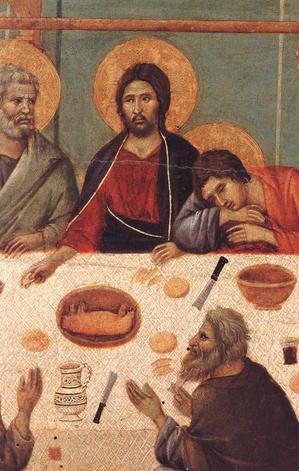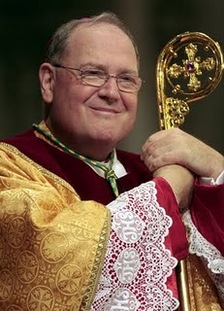 Here we are: Spy Wednesday, the eve of the sacred Triduum. Lent is about to end and we’re entering into a liturgical period and facing the Paschal Mystery of Christ. The term “Spy Wednesday” is not heard often these but we get the point: the struggle between life and death, sin and grace, friendship and betrayal, good and evil.
Here we are: Spy Wednesday, the eve of the sacred Triduum. Lent is about to end and we’re entering into a liturgical period and facing the Paschal Mystery of Christ. The term “Spy Wednesday” is not heard often these but we get the point: the struggle between life and death, sin and grace, friendship and betrayal, good and evil.
At home with Pope Benedict
 Time Magazine published a now translated story written by Andrea Tornielli of La Stampa. Tornielli did a recent piece on the Pope’s living arrangements and the people living and working with him. Last week I mentioned that a new member of the Papal Household was introduced recently to Benedict’s family.
Time Magazine published a now translated story written by Andrea Tornielli of La Stampa. Tornielli did a recent piece on the Pope’s living arrangements and the people living and working with him. Last week I mentioned that a new member of the Papal Household was introduced recently to Benedict’s family.
Pope Benedict XVI: 6 years as Pontiff
 Before going to the Noon Mass, I want to offer this prayer for Pope Benedict on the 6th anniversary of his election as the Supreme Pontiff. Be sure to unite your intentions when you receive Holy Communion and pray the rosary for Benedict and the Church. May the Lord bestow on the Pope the graces needed to live a holy life and to lead the Church unto salvation.
Before going to the Noon Mass, I want to offer this prayer for Pope Benedict on the 6th anniversary of his election as the Supreme Pontiff. Be sure to unite your intentions when you receive Holy Communion and pray the rosary for Benedict and the Church. May the Lord bestow on the Pope the graces needed to live a holy life and to lead the Church unto salvation.
prostrate here at thy feet, we pray Thee to save, defend, and long preserve the
Vicar of Christ, Pope Benedict XVI the Father of the glorious society of souls,
our own Father. Today and every day he prays for us, fervently offering to Thee
the sacred victim of love and peace. Turn then, O Lord, thy loving eyes upon
us, who forgetful as it were of ourselves pray now above all things for him.
Unite our prayers with his, and receive them into the bosom of thy infinite
mercy, as a most sweet perfume of that living and efficacious charity, in which
the children of the Church are united to their Father. All that he asks of Thee
today we too ask for with him. Whether he sorrows or rejoices, or when he hopes
or offers the victim of love for his people, we would be united with him. We
desire that the utterance of our souls should be one with his. Amen.
What’s the difference between beatification and canonization?
Subtle
differences need certain light in a canonization process. Scholasticism
advocates that we always distinguish. Benedict XVI will be beatifying his
friend, colleague and boss, Pope John Paul II on May 1. So, the faithful are
asking what’s the difference between the ecclesial acts of beatification and
canonization?
The Holy See told us what’s considered to be the distinguishing
marks of any beatification. There are three differences:
- location of dioceses
that can hold annual public liturgical celebrations in the holy person’s honor; - who ceremonially requests the pope to act;
- and the level of papal authority
involved in the proclamation.
What Pope Benedict has worked hard to remind the
Church, “at a beatification ceremony, the bishop of the diocese where the
person dies asks that the candidate be declared blessed; at a canonization, the
prefect of the Congregation for Saints’ Causes speaks in the name of the whole
church and asks that the candidate be declared a saint.”
But a central
difference between a beatification and canonization is that with a canonization
there is an act of declaring dogmatically, that God has revealed this person
with Him in beatitude. Essentially, it is a matter of papal infallibility.
Being a saint is a dogmatic statement; being a blessed is not. A saint can be
liturgically commemorated at the sacred Liturgy worldwide and remembered in
other circumstances like naming buildings after the person. When the Church
says a person is a blessed, it is an administrative act of the papal office; a
blessed can be liturgically commemorated is limited to certain circumstances,
like where the person lives or in the houses of the religious congregation
should the person be a religious.
Archbishop Dolan to celebrate the St Gianna Mass at St Catherine of Siena Church NYC
 On Wednesday, the 27th April, at the Church of St.
On Wednesday, the 27th April, at the Church of St.
Catherine of Siena (411 E. 68th St.) Archbishop Timothy M. Dolan will offer the Sacrifice of the Mass for the intention of couples struggling with infertility &
pregnancy-related difficulties. The evening will begin with Mass at 6:30 pm,
followed by comments by Mr. Robert White, President of the St. Gianna Society followed by a blessing
with the St. Gianna relics by the Archbishop.
for personal veneration of St. Gianna relics – with a light reception following
Mass. Physicians, including Dr. Anne
Mielnik, and other practitioners specializing in infertility will be
present in reception area to answer questions and offer support following Mass.
For more info, check out the flyer: St. Gianna Flyer 2011.pdf
Vatican newspaper online
 The Roman Observer (in Italian L’Osservatore Romano) is now online –and free till August.
The Roman Observer (in Italian L’Osservatore Romano) is now online –and free till August.
Portsmouth Abbey Monks face future with internet help
 Benedictine monasticism has a beautiful way of adapting, in a sensitive and intelligent way, to the times. Being contemporaneous doesn’t mean trendy. It means, in my mind, taking seriously the fact of the Incarnation: that in all things God may be glorified. Pope Benedict has been advocating the prudent use of social media, a point for this blog!
Benedictine monasticism has a beautiful way of adapting, in a sensitive and intelligent way, to the times. Being contemporaneous doesn’t mean trendy. It means, in my mind, taking seriously the fact of the Incarnation: that in all things God may be glorified. Pope Benedict has been advocating the prudent use of social media, a point for this blog!
Continue reading Portsmouth Abbey Monks face future with internet help
Walking that new path of liberation by the gravitational force of God’s love, Pope Benedict tells
Pope Benedict is nothing if not a master of the spiritual life and superb pastor of souls. His Palm Sunday homily delivered earlier today is extraordinarily beautiful for its content and style , but most importantly it gives us a path to Jesus. He’s not giving a legacy; he’s giving us truth.
It is a moving
experience each year on Palm Sunday as we go up the mountain with Jesus,
towards the Temple, accompanying him on his ascent. On this day, throughout the
world and across the centuries, young people and people of every age acclaim
him, crying out: “Hosanna to the Son of David! Blessed is he who comes in the
name of the Lord!”
But what are we really doing when we join this procession as
part of the throng which went up with Jesus to Jerusalem and hailed him as King
of Israel? Is this anything more than a ritual, a quaint custom? Does it have
anything to do with the reality of our life and our world? To answer this, we
must first be clear about what Jesus himself wished to do and actually did.
After Peter’s confession of faith in Caesarea Philippi, in the northernmost
part of the Holy Land, Jesus set out as a pilgrim towards Jerusalem for the
feast of Passover. He was journeying towards the Temple in the Holy City,
towards that place which for Israel ensured in a particular way God’s closeness
to his people. He was making his way towards the common feast of Passover, the
memorial of Israel’s liberation from Egypt and the sign of its hope of
definitive liberation. He knew that what awaited him was a new Passover and
that he himself would take the place of the sacrificial lambs by offering
himself on the cross. He knew that in the mysterious gifts of bread and wine he
would give himself for ever to his own, and that he would open to them the door
to a new path of liberation, to fellowship with the living God. He was making
his way to the heights of the Cross, to the moment of self-giving love. The
ultimate goal of his pilgrimage was the heights of God himself; to those
heights he wanted to lift every human being.
Palm Sunday of the Lord’s Passion
Saint Robert of Molesme
 April 17, 2011 marks the 900th anniversary of the
April 17, 2011 marks the 900th anniversary of the
death of St. Robert of Molesme, which, this year, is Palm Sunday. This anniversary of death of Saint Robert coincides with the historic beginning of the Cistercians with Robert’s arrival with his group of monks first arrived at
Cîteaux on Palm Sunday (March 21, 1098). Along with Saints Alberic and Stephen, Saint Robert is one of the founders of Cîteaux.
is available here. You’ll find the rather lengthy article referred to at: Life of St.
Robert of Molesme. A shorter version of Saint Robert’s life can be
found on Wikipedia.

